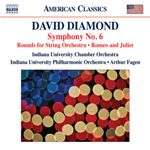|
Back
07/13/2018
David Diamond: Rounds for String Orchestra – Music for Shakespeare’s Romeo and Juliet – Symphony n° 6
Indiana University Chamber Orchestra, Indiana University Philharmonic Orchestra, Arthur Fagen (conductor)
Recording: The Musical Arts Centre and Auer Hall, Indiana University, Bloomington, Indiana (December 7-10, 2015 and February 22-24, 2016) – 65’38
Naxos 8.559842 – Booklet in English

   
A recent article in The American Scholar lists the author Sudip Bose’s “25 of the very best” American symphonies, starting with Louis Moreau Gottschalk’s Symphony n° 1 of 1859 and ending with Christopher Theofanides’ Symphony n° 1 of 2009. Charles Ives gets three works listed, but the others just one each. Thus there are 23 names on the list, and David Diamond’s is not among them.
I realize such a list is far from the last word (it would be interesting to canvass knowledgeable critics and academics to achieve a consensus), but it exemplifies the position of Diamond and several other prolific composers of the recent era. He lived from 1915 to 2005, long enough to see his music ebb from a prestigious and promising place it held in the repertoire, although he remained an honoured name. Among his numerous works he wrote 11 symphonies between 1940 and 1991 (plus two earlier discarded symphonies).
This recording presents three works from his era of greatest success. Rounds for String Orchestra (1944), is a 15-minute work with three linked movements. Robert Lintott’s informative notes draw a comparison between its slow movement and Samuel Barber’s Adagio for Strings of 1936. Such comparisons are hazardous; the Barber work has a unified intensity that renders Diamond’s agreeable, well crafted piece workaday.
In 1947 Diamond composed Music for Shakespeare’s Romeo and Juliet, also for string orchestra. The booklet states “it is far more restrained than the 20th century’s other great Romeo and Juliet”, that of Prokofiev. Here is another devastating comparison. Some years ago I attended a program of music inspired by Pelléas et Mélisande which included nothing by Debussy, but works of Fauré, Sibelius, and Schoenberg. Each work was distinctly different from the others, and all held their place on the program. I can’t imagine Diamond’s noncommital work making much of an impression alongside similarly-inspired music by Berlioz, Tchaikovsky or Prokofiev.
Which brings us to Diamond’s Symphony n° 6. It dates from the early 1950s, and it was premiered by the Boston Symphony Orchestra under Charles Munch in 1957. After a Carnegie Hall performance, it was savaged by the New York Times critic who took issue with its supposed refutation of compositional tradition. It is hard to believe he heard what is on this CD. Diamond is among those composers who did NOT espouse serialism or 12-tone or whatever were the trends of the day, but he adhered to traditional thematic development as is clearly demonstrated by this symphony. This vigorous work, about 27 minutes in length, deserves to be heard. This, by the way, is its first recording.
Are the stylistic wars over? Audiences have long become wary of anything composed after the 1930s (or some such date), which is a pity. The Naxos label’s American Classics series contains recordings of five other David Diamond symphonies, all by the Seattle Symphony under Gerard Schwartz. The symphonies, at any rate, are worth a hearing. One of them might yet appear on a “top 25" list.
Michael Johnson
|